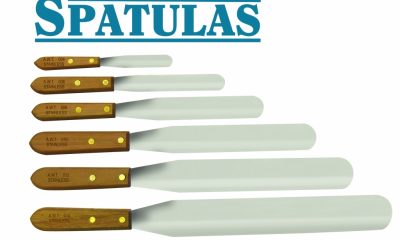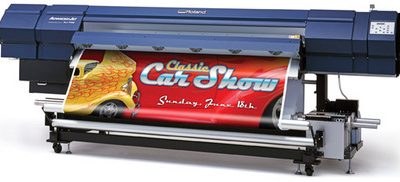Business & Industry
Published
21 years agoon
What exactly are products? The stuff you sell? Congratulations! You know more than I did when I planned my first product-advertising program. I remember it well and still cringe at the recollection. I had just installed my first all-new, flat-stock, UV-curing production line. I was terribly proud of it, so my first advertising brochure, distributed to current and potential clients all over New England, trumpeted the advantages of my new, high-tech equipment. The best thing that can be said for my advertising efforts is that as far as I could tell, it didn’t cost me any clients.
What exactly are products? The stuff you sell? Congratulations! You know more than I did when I planned my first product-advertising program. I remember it well and still cringe at the recollection. I had just installed my first all-new, flat-stock, UV-curing production line. I was terribly proud of it, so my first advertising brochure, distributed to current and potential clients all over New England, trumpeted the advantages of my new, high-tech equipment. The best thing that can be said for my advertising efforts is that as far as I could tell, it didn’t cost me any clients. You may have a solid definition of what your products are, but you still may not know enough about your products to successfully move them from your company to the hands of your customers. In this article, I’ll discuss the life cycle of a product and present five important lessons that will not only help you successfully introduce and sell your goods, but also keep them on the market after their newness wears off. Lesson one: Goods and services Customers buy the product, not the process. Whether the products are screen printed, inkjet imaged, or hand painted by Santa’s elves, the customer doesn’t care. Let’s get back to my question, "What is a product?" Ideas can be products. Have you any doubt that Pope John Paul II is selling an idea? A person can also be a product. We’re entering a political season (and good luck to all you lawn-sign printers reading this). Look at all the politicians selling themselves but with not an idea in sight. A place can also be a product, judging by the advertising that Maine does every spring. In the most general terms, a product is something that producers create to satisfy consumers’ needs. Screen printers seldom get involved in selling ideas, people, or places, at least not directly. The most common categories of products for screen printers are goods and services, which we’ll focus on in this article. Lesson two: Product attributes Many of the problems producers have with customers come from the difference between how they define what they are selling and how customers define what they are buying. Can we agree that the better the communication between you and your customers, the more likely you are to make a sale? A question I often ask is, "You want to sell and the customer wants to buy, so why are you yelling at each other?" Could it be that you and your customer can’t agree on what the product is? Products, whether goods or services, are defined by attributes, which can be tangible or intangible. Tangible attributes are physical values that can be measured, counted, or in some other way specified in terms of numbers. Examples of tangible attributes include size, quantity, or color. But products also contain intangible attributes. For example, a Lexus and a Yugo are both cars (if you are willing to stretch the definition a little, and if you can still find a working Yugo). In addition to the many tangible ways that a Lexus and a Yugo differ, the Lexus has the intangible attribute that we may loosely describe as luxury, and the Yugo has the intangible attribute that some describe as junk. One of the intangible attributes that all of your products have is your reputation, or lack thereof, for producing a quality product, on time, for a reasonable price. You, the producer, probably deal mostly with tangible products. For example, when you write an order for bumper stickers for a political candidate, you specify the size, quantity, design, colors, substrate, etc. These are the tangible attributes of the product. Even though your customers specify tangible attributes when they buy your products, these attributes are more important to you and less important to your customer. Do you have a highly accurate color-matching system? An on-time delivery guarantee? Free shipping within the state? These are also product attributes, referred to as extended attributes. Extended attributes are usually more important to your customer than tangible attributes, but often producers consider them as an afterthought, if they consider them at all. Generic attributes exist entirely in the mind of your customer. The political candidate who buys your bumper stickers has no burning desire to own 5000 pieces of brightly decorated vinyl. What he or she really wants is an easy and inexpensive method of communicating a very simple idea (vote for me) to as many voters as possible and as rapidly as possible. If tattoos worked better, politicians would line up for body art. The blunt truth is that customers buy your product not because you are a super salesman, a heck of a good guy, or the best screen printer in your state. They buy because they expect that your products will satisfy their wants or needs through a benefit that they think your product will provide. Politicians buy bumper stickers because they want votes, and they expect bumper stickers to help them fulfill that need. An analysis of generic attributes concentrates on the benefits that the customer desires–benefits that he or she hopes to achieve by purchasing your products. Most screen-printing businesses focus their time and attention on the tangible attributes of their products. More successful screen-printing business managers also consider the extended attributes of their products. Only the most successful screen-printing business managers spend most of their time trying to understand the generic attributes of their products. Lesson three: Product life cycle All products have a life cycle, and different types of products have different life cycles. Every product, ranging from the pet rock to the automobile, goes through four life-cycle phases. First, products are rolled out during the introductory phase. Some products, very few, progress beyond the introductory phase into the growth phase. Some of the products in the growth phase will last long enough to grow into the mature phase. And all products that make it to the mature phase will, sooner or later, experience a phase of decline. Why do you need to know this? If you don’t understand the life cycles of the products you sell, then your business, like a mature product, will sooner or later enter its decline phase. As a marketer, your goal for a product in the introductory phase is to find customers for it. You must create a demand, or link the benefits that your product can provide to the needs of a sufficient number of customers to make it worthwhile to produce the product. In terms of sales, a product in the introductory phase has nowhere to go but up. Once you establish a sufficiently large market for the product, it enters the growth phase. In this phase, you attempt to increase sales by expanding distribution and the range of available options for the product. Products that complete the growth phase next enter the mature phase. At this point, you should have a fully developed distribution system for the product. There is little room for growth in the market because all the potential customers have become actual customers. Concentrate on maintaining your market share and developing differential advantages such as lower prices, better warranties, more variations, better availability, and new and improved versions. Once sales of a product begin to decline, your options for the product are limited. You can reduce overhead costs by cutting back on marketing, promotions, range of product options, and distribution. You can relaunch the product to start the product life cycle all over again at the introductory phase by repositioning or repackaging it as a new product or for a new market. You can also stop making and selling the product. So far, I have discussed the rise and fall of a sales curve in the product life cycle. What about the profits? During the introductory phase of a product, profits are less than zero. The cost of developing and introducing a product makes it impossible to make a profit. If your business finances are so fragile that every product you sell has to be profitable from the first job, don’t waste your time and money developing new products. You can’t afford it. Products don’t start to become profitable until they enter the growth phase, and once there, profits sharply increase. Life is good, and like all good things, the growth phase and its rapidly growing profits will not last long. At the end of the growth phase, profits start to level off. Why? Because profits attract competition like an airplane crash attracts lawyers, and for exactly the same reason. During the maturity phase, sales may increase for a while, but profits will inevitably trend down because prices start to fall as you and your competitors engage in a fierce struggle over a static market. Eventually, the market consolidates and only the most successful producers have significant market share. In the decline phase, profits drop precipitously but not all the way to zero. There are modest profits to be made for the few producers left in the market, if they are efficient and frugal enough. Why is an understanding of the product life cycle important to you? I have seen too many companies waste too much manpower and money trying to promote a product using inappropriate marketing methods. There’s no point in expecting a profit from a product that is still in the introductory phase. Marketing methods that worked for a product in the growth phase are a waste of time and money for mature products. Pricing structures that used for growing products are inappropriate for mature or declining products. Lesson four: Product life cycle revisited Unless you know what product-life-cycle phase your products are in, you can’t know how to market and price the products. The product life cycle is not carved in stone. Different types of products have dramatically different life cycles, even though they all go through roughly the same phases. You can use the product-life-cycle concept to analyze your products, but it is not useful for forecasting sales. A product in the mature phase may move on to the decline phase in a matter of months, or it may remain in the mature phase for many years. With careful marketing, it is possible to manipulate a product life cycle and find new markets for products in decline. On the flip side, the product life cycle may become a self-fulfilling prophecy. If the perception is that sales of a product will inevitably decline because it is transitioning from the mature to the declining phase, the company may decide to preserve profits by cutting back on marketing, and as a result, sales do decline. Is this due to the product life cycle or the cut back in marketing efforts for the product? Lesson five: Beating the product life cycle Even a thorough understanding of the product life cycle will not solve all your marketing problems. If all products eventually decline into obsolescence, how will you keep your business growing and profitable? There are two solutions to that question. One solution is expensive; the other solution is difficult. I recommend that you adopt both. The first solution to the problem of product obsolescence is continual innovation. Constantly develop new uses and new markets for current products. Search for new products that you can use to satisfy the needs and wants of your current customers. This is an expensive, time-consuming, and sometimes maddeningly difficult procedure. Product innovation can suck down time and money like a black hole. The failure rate (product launches vs. products that show a profit) is infuriatingly high. On the positive side, product innovation can be a lot of fun. Remember, you can’t predict when your cash cow, the product that pays about 80% of the bills in your business, will tip over from mature phase into decline phase and start the long slide down to zero profitability. You better start looking for a replacement now. The second solution lies within a product brand. Unlike other types of products, a brand does not have to become obsolete. It’s impossible for any one business to own a product category (to be the only T-shirt or bumper-strip printer), but if you do establish a brand, it’s all yours. You can transfer a brand from product to product as established products become obsolete and you introduce new products to replace them. When I refer to brands, I’m not referring to Proctor and Gamble’s or Anheuser-Busch’s use of brands. You don’t need to register your name or the name of your business with the federal government. You can establish a brand in other ways. Do you have an attractive, well-designed business logo? Is it displayed on your building, fleet vehicles, business cards, letterheads, envelopes, and invoices? That’s an effective graphic representation of your brand. Are all your employees trained to provide superlative customer courtesy? Do you deliver a quality product on time every time? That’s an effective behavioral representation of your brand. The name of your business is your brand. It’s a product that no competitor can produce. What are you doing today and every day to make sure that your brand is the first choice in your market area for customers who need screen-printed goods to satisfy their wants and needs? Hopefully, you’ve gained a thorough understanding of a product’s life cycle and its relevance to developing marketing programs and selling your products. Now go out there and put these lessons to practice.

Subscribe

Magazine
Get the most important news
and business ideas from Screenprinting Magazine.
Most Popular
-

 Art, Ad, or Alchemy1 month ago
Art, Ad, or Alchemy1 month agoF&I Printing Is Everywhere!
-

 Case Studies1 month ago
Case Studies1 month agoHigh-Density Inks Help Specialty Printing Take Center Stage
-

 Andy MacDougall1 month ago
Andy MacDougall1 month agoFunctional and Industrial Printing is EVERYWHERE!
-

 Columns2 weeks ago
Columns2 weeks ago8 Marketing Mistakes Not to Make When Promoting Your Screen Printing Services Online
-

 Editor's Note2 weeks ago
Editor's Note2 weeks agoLivin’ the High Life
-

 Thomas Trimingham2 months ago
Thomas Trimingham2 months ago“Magic” Marketing for Screen Printing Shops
-

 Marshall Atkinson2 weeks ago
Marshall Atkinson2 weeks agoHow to Create a Winning Culture in Your Screen-Printing Business
-

 News & Trends1 month ago
News & Trends1 month agoWhat Are ZALPHAS and How Can You Serve Them in Your Print Business?






